Dedicated to you, the parents, who provide for your children the joy and fulfillment of learning to dance. May they be an endless source of inspiration and pride. ~Aleksansra Efimova
2. Insole
3. Shank
4. Outer Sole
5. Box
6. Wings
7. Pleats
8. Back Seam
9. Waist Seam
10. Heel Section
11. Vamp
12. Platform

MY FIRST POINTE SHOES:
A Parents Guide
WELCOME TO THE MAGICAL AND EXCITING WORLD OF POINTE!
Buying her first pointe shoes is a momentous occasion for a young dancer, eagerly and sometimes impatiently awaited. Beginning pointe work is a true milestone and a sign of artistic maturation, and nothing can match the thrill of putting on that first pair of beautiful, pink satin shoes.
In the midst of this excitement, it’s important to remember that starting points is not a step to be taken lightly. To safely dance on pointe, a dancer needs careful preparation, adequate strength and development, and a pair of pointe shoes that has been professionally fit to match her unique foot shape and individual technique. Before your child begins pointe work, take some time to get to know all the factors involved. For a good start, read the answers to the frequently-asked questions assembled in this guide.
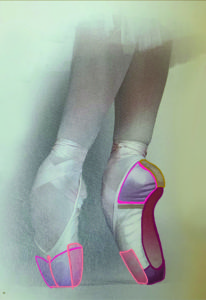
How should point shoes fit?
Pointe shoes must fit snugly. Loose shoes greatly decrease a dancer’s control of movement and increase her chances of injury. For this reason, it is impossible to buy pointe shoes “to grow into,” and they may feel strangely tight at first.
Your child’s fitter will ask many questions to determine whether the shoes are really too tight, or just snug in an unfamiliar way. Pointe shoes should never be tight enough to cause pain. In a properly-fitting shoe, the toe box sits smoothly against the toes, with all five toes flat against the insole. The heel is snug when the dancer stands on flat; on pointe, there is a little pinch in the heel fabric. On pointe, the dancer’s weight is evenly distributed on the toes, she is balanced on the center of the platform, and the feet do not sink into the toe box.
In the right shoes, the dancer is property supported and shows correct alignment: the shoe is basically vertical from toe to heel, with no sharp angle at the metatarsals, and an imaginary vertical line can be drawn from the head to the toes.
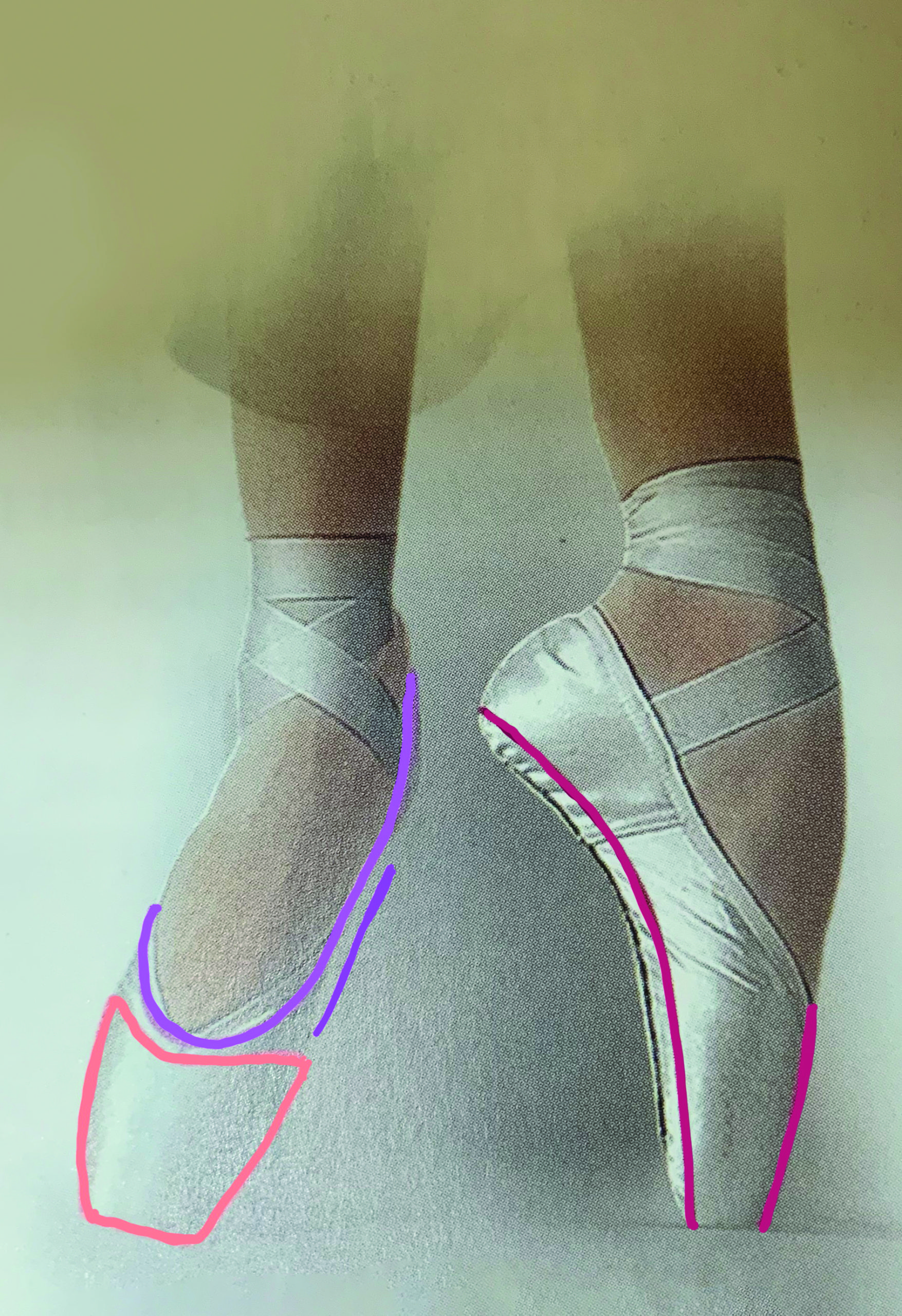
How do you pointe shoes support the weight?
Two parts of the pointe shoe work together to support the entire weight of the body on the platform of the shoe. The firm toe box holds the toes together and keeps them straight. The sole includes a stiff shank, usually a layer or several layers affirm but flexible cardboard material between the insole and the outsole. The shank supports the entire foot, giving extra strength on pointe. A dancer should never rely on an overly stiff shank, however. Instead, she must develop so much strength that the pointe shoe is a partner, not a prop.

What is my role during my child’s fitting?
Encourage your daughter to listen to the filter’s questions and answer them as specifically as she can. and to speak up about any discomfort or questions she has during the fitting. Talk with her ahead of time about how the shoes should feel: snug and supportive but not painful or pinching. (Examples of overly tight shoes: little toes are pinched, big toe feels jammed or stubbed, toes don’t lie flat, sole of foot is squeezed or creased.) You may teach your daughter to point to the places where a shoe feels wrong, or to use her hands to demonstrate what her feet are feeling (the hands and feet have similar bone structure).
Prepare your daughter, and facilitate communication if necessary. During the fitting itself, though, you should try to step back and let the fitter do his or her
What is the teachers role in my child’s feeling?
Teachers can help you find a reliable fitter, and some teachers attend or arrange the first fittings. An expert pointe teacher knows how pointe shoes should fit and work with the feet, and that different dancers need different pointe shoe models fora proper fit. Most teachers require students to bring their first points shoes for approval before wearing them: do not sew ribbons onto the shoes, or allow them to be worn or get soiled, until your daughter’s teacher has approved them. Along with you and the fitter, the teacher is an essential part of your daughter’s pointe support team. When everyone works together, she has the best chance of success on pointe.
When should I replace my child’s shoes?
Pointe shoes are replaced for several reasons, ir growth, change in foot shape, technical development, and worn-out shoes. may be outgrown more quickly than street shoes. shoes that are too tight or no longer the right shape can damage the feet. Signs that shoes are worn out include lack of support in the toe box or platform and over-flexing in the shank. With pointe shoes, appearance can be deceiving. A shoe may look almost new but be structurally worn out, or appear dirty and worn but still be fully functional. Your daughter’s teacher or fitter can help determine if a pair of shoes is still wearabte. With only a short time on pointe each week, many beginners are able to wear shoes until they are outgrown, and may need only a pair or two in the first year on pointe. In contrast, many professional dancers wear each pair only once! Parents of advanced students should be prepared for the expense of frequent shoe replacement.
Is it possible to make them last longer?
You can usually expect about 12-15 hours of wear from a pair of pointe shoes. To get the most out of that lifespan, follow some basic care principles. Because they are made of healthy, natural materials, most pointe shoes break down when wet. Encourage your daughter to use a mesh bag to carry her pointe shoes after class. Some dance bags come with external mesh bags just for this purpose. She should also remove toe pads immediately after use and store them separately from her shoes. Always set the shoes out to air-dry thoroughly between classes, ideally for at least 24 hours. When dancers wear pointe shoes every day, they often buy more than one pair at a time so that each pair’has time to dry completely before being worn again.
How should we should we sew on the pointe shoe ribbons?
These diagrams show the most basic method of sewing ribbons. As your child becomes more advanced, she may develop her own preferences, such as moving the ribbon placement slightly forward or back.
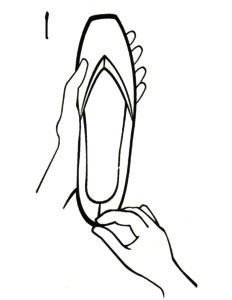
Take the heel of the pointe shoe…
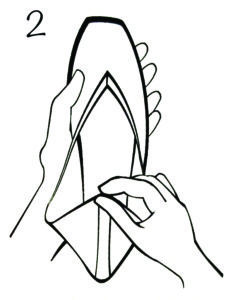
… And pull it all the way forward.
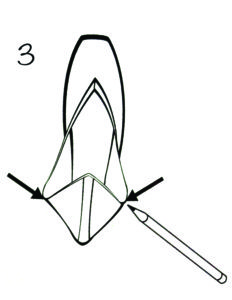
Make pencil marks inside the folds (See arrows).
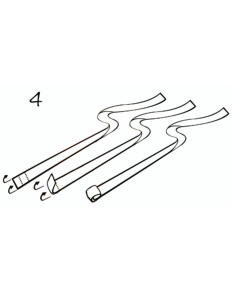
before you saw each ribbon, double-fold one end. So the folded end inside the shoe, on the mark you made in step 3
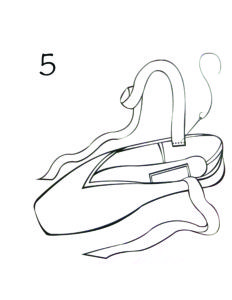
What else will my daughter need for her pointe shoes?
Most dancers use toe pads for comfort inside the box. Dancers vary in what kind of padding they use, but the lighter padding usually leads to better control and fit. Beginners should only use padding designed for Pointe shoes, and never experiment with other materials. Extras such as toe spacers, toe tape or heelpads should only be added if the fitter or teacher considers them necessary.
How else should she prepare her shoes?
Most dancers sew elastics to their pointe shoes for added support. Elastics may be sewn in a single length around the ankle from one side of the heel to the other, or in two lengths crisscrossing the instep of the foot from heel to side of shoe. Perfectly fit pointe shoes require little or no other preparation. Professional dancers may have elaborate rituals for preparing their shoes, but beginners should never alter their shoes in any way unless their teacher or fitter recommends it. Banging or bending the shoes, or attempting to modify their design, can compromise their structure in potentially dangerous ways. The “breaking-in” process should be accomplished through exercises in pointe class.
What is the role of the dance store in my daughters life?
The dance store is important as a source of appropriate dancewear, shoes and accessories. In addition, the dance retailer is often a wonderful source of information about training, performance and the events and organizations in the local artistic community, and can be a special part of your daughter’s support team. Most essentially, professional pointe fitting takes place almost exclusively in dance stores. As long as she dances on pointe, your daughter will continue to need the personal care of a professional fitter to ensure the safest and most satisfying technical development and dance performance.
Glossary
Pointe shoes are specially designed to help me Dancer perform on the tips of her toes. they are also sometimes called toe shoes.
The foot…
Arch The curve of the sole of the foot.
Instep The curve of the top of the foot. metatarsals Five long bones connecting the forefoot to the heel area. The metatarsal area usually refers to the ball of the foot: the end of the
Metatarsals Five long bones connecting the forefoot to the heel area. The metatarsal area usually refers to the ball of the foot: the end of the metatarsal nearest the toes.
Bunion deformity and inflammation of the big toe joint, often very painful. Proper pointe fitting and training help dancers avoid or delay bunion development.
Achilles tendon The largest tendon in the body, running from the heel bone into the calf. Ribbons should always be tired, and elastic strong song, slightly to the side, never directly on the achilles
The Shoe…
Toe box is stiffened to keep the toes straight and The toe box softens with use; when it gets too
Platform The flat area at the tip of the toebox. This is the surface on which the dancer balances on pointe.
Shank The firm but flexible supportive layer in the sole of the shoe.
Vamp The part of the shoe that covers the top, or front, of the toes. Dancers choose a high (long) or low (short) vamp based on their toe length and their strength. The curved opening of the vamp is often called the throat. The vamp may open in a V-cut or a U-cut shape.
Crown The height of the toe box, from the sole to the vamp. Dancers choose a high or low crown based on the fullness of their feet at the metatarsals and instep.
Taper The narrowing of the toe box from the metatarsal area to the platform. In order to dance safely and comfortably, dancers need the degree of taper that best matches their foot shape.
Drawstring A string, often elastic, that runs around the binding of some pointe shoes and is used for refining the fit.
Pointe Work…
On pointe On the tips of the toes. Also referred to as en pointe (“ahn pwent”).
On flat Standing with the entire sole of the foot or shoe on the floor.
Demi-pointe Raising the heels but keeping the toes flat on the floor, so that the foot is bent at the metatarsal area.
Releve rising from flat to demi-pointe or pointe.
Rolling to pointe passing through demi-pointe on the way from flat to pointe. Also called rolling through.
Springing to pointe Rising to pointe with minimal roll-through, almost as if jumping onto the toes.

